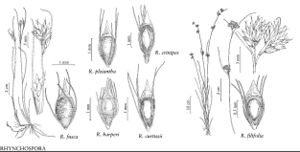Rhynchospora harperi
Man. S.E. Fl., 182, 1503. 1933.
Plants perennial, solitary or cespitose, 50–70 cm; rhizomes absent. Culms erect to excurved, leafybased, narrowly linear, ± terete. Leaves shorter than culm; blades ascending, narrowly linear, proximally flat or margins slightly involute, 0.5–1 (–2) mm wide, distally canaliculate, apex trigonous, tapering, subulate. Inflorescences: spikelet clusters 1–3, laterals 0–2, all turbinate to hemispheric, terminal internode usually excurved; leafy bracts setaceous, overtopping inflorescence. Spikelets redbrown, lanceoloid, 5–7 mm, apex acute; fertile scales lanceolate, (2.5–) 4–5 mm, apex acute to acuminate; midrib paralleled by several indistinct ribs, excurrent as short awns. Flowers: bristles 6, reaching from mid tubercle to beyond tip. Fruits 3 (–4) per spikelet, 2.1–2.5 mm; stipe and receptacle 0.2–0.3 mm, sparsely setose and setulose; body glossy, brown with pale center, obovoidlenticular, 1.1–1.5 × 1–1.1 mm, surfaces finely longitudinally lined, variably low papillatecancellate, also often transversely with wavy lines of dark dots; tubercle flattened, triangularsubulate, (0.8–) 0.9–1 (–1.1) mm, setulose-ciliate.
Phenology: Fruiting summer–fall.
Habitat: Sands and peats of bogs, stream banks, edges of pineland savanna ponds, Hypericum ponds
Elevation: 0–100 m
Distribution

Ala., Del., Fla., Ga., Md., Miss., N.C., S.C., Central America (Belize)
Discussion
Rhynchospora harperi is most abundant in a very special habitat referred to here as the “Hypericum pond.” These are typically shallow ponds in pine savannas, frequently ringed by stands of Nyssa, Taxodium, Ilex, and Cyrilla, but most of the pond itself is dominated by one or more myriandrous shrubby Hypericum species. Here R. harperi is distinguished from other species by the often abrupt bend of its ultimate internode.
Selected References
None.
Lower Taxa
"shortened" is not a number."wider" is not a number.
